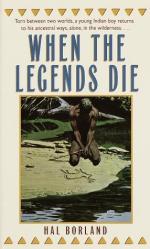|
This section contains 363 words (approx. 1 page at 400 words per page) |

|
When the Legends Die Summary & Study Guide Description
When the Legends Die Summary & Study Guide includes comprehensive information and analysis to help you understand the book. This study guide contains the following sections:
This detailed literature summary also contains Bibliography and a Free Quiz on When the Legends Die by Hal Borland.
Hal Borland's When the Legends Die, published in 1963, immerses the reader in two worlds, that of the wild West and that of wild nature, two topics with which Borland was quite familiar. Written in 1963, around the height of Borland's writing career, the story follows a young Native American boy as he struggles not only with the rite of passage to manhood but also with the harsh realities of the clash of his native culture and the modern white society. Having been raised in the traditional ways of his Ute ancestors, the protagonist of the story must first learn the "new ways" of the white people who dominate his world before he can create a clear identity of who he is and where he fits in his environment.
The novel was well received and eventually was produced by Twentieth Century Fox as a movie in 1972. When the Legends Die is often compared to Jack London's Call of the Wild (1914), which takes up the theme of the wilderness, and Conrad Richter's The Light in the Forest (1953), which deals with the clash of cultures in the West. All three books explore rite of passage or coming of age themes, and all three were produced as movies.
The story of Thomas Black Bull, the protagonist of Borland's novel, is one of constant transformation as a young boy searches for an identity. Symbolizing this most clearly is the fact that, throughout the story, Thomas's name is changed several times. He receives the name Little Black Bull from his parents, which is changed to Thomas Black Bull when a white minister baptizes him. Then, as he nears puberty, Thomas gives himself the name of Bear's Brother. When he becomes popular on the rodeo circuit, his fans dub him with the moniker Killer Tom. As he works out his frustration and anger from losing his parents before reaching puberty, being forced to enter a school to learn white society's ways, being used by swindlers and crooks as well as by people who need heroes, Thomas tries on many personas, but, in the end, he finds his way back home and is finally able to define his own identity.
Read more from the Study Guide
|
This section contains 363 words (approx. 1 page at 400 words per page) |

|



